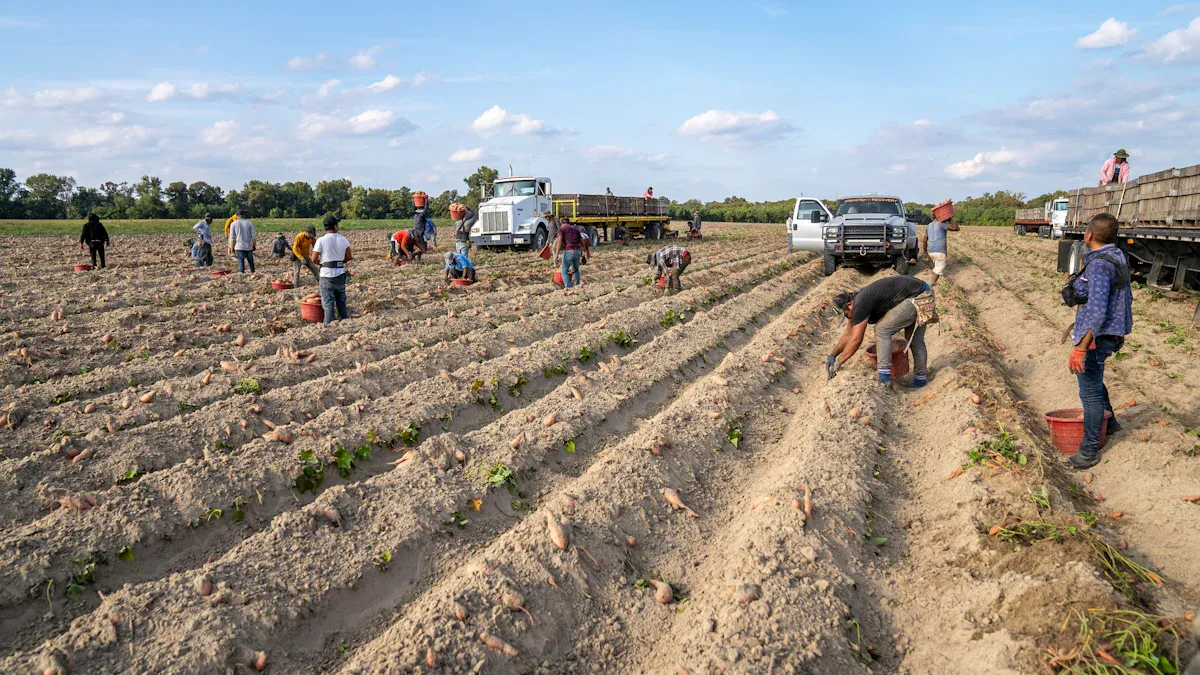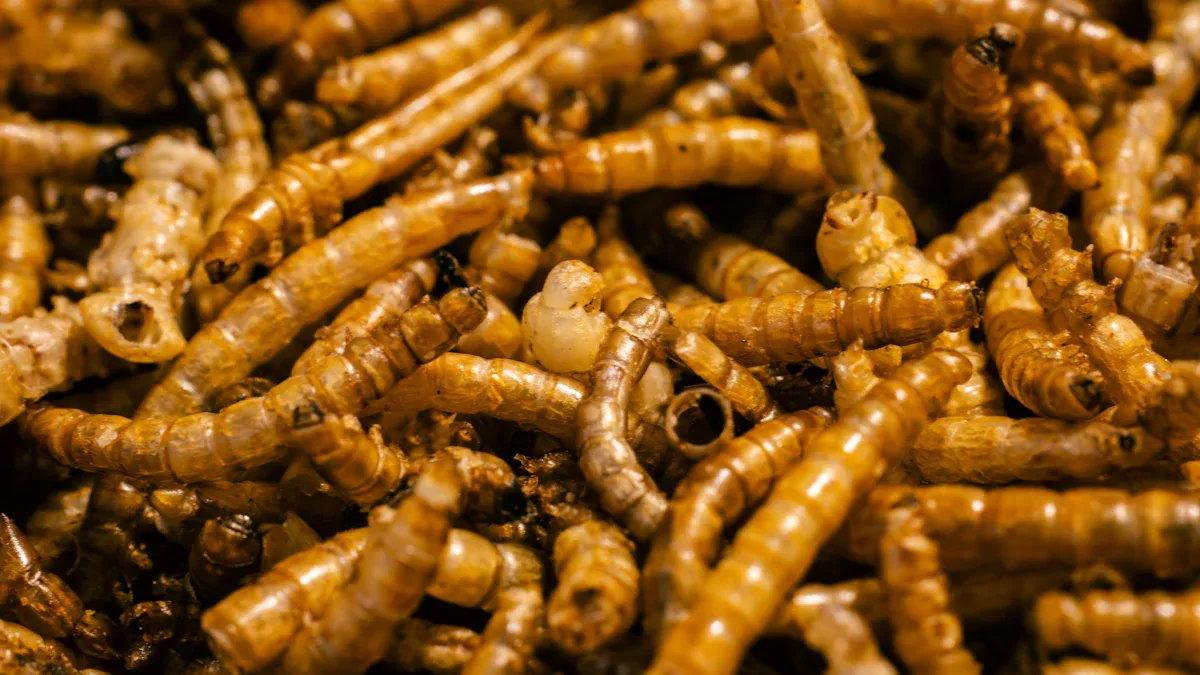
Farmers are always on the lookout for smarter ways to boost productivity. Dried mealworm for farms offers a game-changing solution. These tiny insects pack a punch with their high protein content, improving feed conversion rates by up to 10% in broilers. Plus, they’re eco-friendly. Producing mealworms uses 3.5 times less water than beef, making them a sustainable choice.
Key Takeaways
- Dried mealworms are rich in protein and fat. They help animals grow faster and eat more efficiently.
- Using mealworms can cut feed costs and reduce farming pollution.
- Mealworm waste improves soil health and works as eco-friendly fertilizer.
Nutritional Advantages of Dried Mealworm for Farms

High Protein and Fat Content for Livestock Growth
Dried mealworm for farms is a powerhouse of nutrition, especially when it comes to protein and fat. With a protein content ranging from 47% to 60%, mealworms surpass traditional feed sources like soybeans, which contain only 44.51%. Their lipid content, ranging from 31% to 43%, provides essential energy for livestock growth. This makes them an excellent choice for farmers aiming to boost the growth rates of their animals.
Here’s a quick comparison:
| Nutrient | Dried Mealworms | Traditional Feed Sources |
|---|---|---|
| Protein Percentage | 51% | N/A |
| Fat Percentage | 19% | N/A |
Farmers can rely on mealworms to meet the dietary needs of their livestock while reducing dependency on less sustainable protein sources.
Rich Source of Essential Nutrients for Animal Health
Mealworms are more than just protein and fat. They’re packed with essential nutrients like zinc, magnesium, and B vitamins, which are crucial for animal health. Studies show that substituting fish or soybean meal with mealworms can improve growth performance in hens and broilers. Additionally, mealworms provide polyunsaturated fatty acids, which promote better immunity and overall health in animals.
Did you know? Adding fermented chicory roots to mealworm diets can increase their mineral content, making them even more nutritious for livestock.
Enhanced Feed Efficiency and Productivity
Farmers often struggle with feed efficiency. Dried mealworm for farms offers a solution. Research shows that replacing soybean meal with mealworms improves feed conversion ratios (FCR) and protein efficiency. Broiler chickens fed with mealworm-based diets showed significant growth without any negative effects on feed intake. This means farmers can achieve better productivity while using less feed.
| Study Title | Key Findings |
|---|---|
| Sustainable farming of the mealworm Tenebrio molitor for the production of food and feed | Mealworms convert feed as efficiently as poultry and have higher nitrogen use efficiency than traditional livestock. |
| Replacement of soy by mealworms for livestock feed – A comparative review | Broiler performance improved significantly when soybean meal was replaced with worm powder. |
By incorporating mealworms into their feeding strategies, farmers can enhance both efficiency and sustainability.
Economic and Environmental Benefits of Dried Mealworm for Farms
Cost-Effective Alternative to Traditional Feed Options
Farmers are always looking for ways to cut costs without sacrificing quality. Dried mealworm for farms offers an affordable alternative to traditional feed options like soybean meal or fishmeal. Mealworms require fewer resources to produce, such as water and land, making them a budget-friendly choice. Their high protein and fat content also means farmers can use smaller quantities while still meeting livestock nutritional needs. This efficiency translates to significant savings over time.
Moreover, mealworms are versatile. They can replace multiple feed components, reducing the need for expensive supplements. Farmers who switch to mealworms often notice a reduction in overall feed expenses, making them an attractive option for cost-conscious operations.
Lower Carbon Footprint Compared to Other Protein Sources
Switching to mealworms isn’t just good for the wallet—it’s great for the planet too. Mealworm production generates far fewer greenhouse gases compared to traditional livestock farming. For instance:
| Ingredient Type | Carbon Footprint (kg CO2-eq per kg) |
|---|---|
| Protein70 (mealworms) | 3.10 |
| High-quality lamb | 5.51 |
| Beef offal | 12.21 |
| Lamb | 23.65 |
Mealworms also require less land and water to produce the same amount of protein as cattle or poultry. They emit lower levels of ammonia and greenhouse gases like CO2 and methane, making them a sustainable choice for environmentally conscious farmers.

Long Shelf Life and Reduced Waste
Dried mealworms have a long shelf life, which helps reduce waste. Unlike traditional feed, they don’t spoil quickly, even in less-than-ideal storage conditions. This durability makes them a reliable option for farms that need to store feed for extended periods.
Additionally, mealworms have a smaller water footprint compared to beef. Producing one ton of edible mealworms requires only 4341 m³ of water, which is comparable to chicken meat but far lower than beef. This efficiency not only reduces waste but also conserves valuable resources, making dried mealworms a sustainable choice for modern farms.
Diverse Applications of Dried Mealworm for Farms
Soil Fertility Improvement Through Mealworm Byproducts
Mealworm byproducts, such as frass (insect waste), offer a natural way to improve soil fertility. Farmers can use frass as an organic fertilizer to enrich their fields. It provides essential nutrients like nitrogen (N), phosphorus (P), and potassium (K), which are vital for plant growth. Unlike traditional fertilizers, mealworm frass enhances microbial activity and soil functioning, promoting healthier crops.
Here’s a comparison of mealworm frass and traditional fertilizers:
| Aspect | Mealworm Frass | Traditional Fertilizer |
|---|---|---|
| Nutrient Supply | Similar effectiveness in N, P, K supply | Depends on type (NPK) |
| Water Soluble P Concentration | Up to five times lower | Higher concentration |
| Microbial Activity | Increases metabolic activity and diversity | Varies, often less beneficial |
| Soil Functioning | Enhances soil functioning | Limited impact |
Scientific studies also show that frass improves nutrient availability in the soil. It increases potassium and phosphorus concentrations while maintaining a balanced pH. This makes it a sustainable alternative to chemical fertilizers.
Supporting Biodiversity and Ecosystem Health
Dried mealworms contribute to biodiversity and ecosystem health by reducing the environmental impact of farming. Producing mealworms requires significantly fewer resources compared to traditional livestock. For example, mealworms need 3.5 times less water than beef, making them a more sustainable protein source. This lower resource consumption helps preserve natural habitats and supports a diverse range of species.
Additionally, mealworm farming emits fewer greenhouse gases, such as methane and CO2. By adopting mealworms, farmers can reduce their carbon footprint and promote a healthier ecosystem. These benefits make dried mealworms an eco-friendly choice for modern farms.
Versatility in Aquaculture and Poultry Farming
Dried mealworms are incredibly versatile in farming, especially in aquaculture and poultry sectors. Their high protein content and essential amino acids make them a great substitute for fishmeal and soybean meal. Studies show that replacing traditional feed with mealworms can improve growth performance and feed efficiency in poultry and fish.
| Evidence Type | Description |
|---|---|
| Nutritional Profile | Mealworms have an essential amino acid content similar to fish and soybean meal, making them a viable alternative for livestock feed. |
| Growth Performance | Studies show that substituting fish or soybean meal with mealworms can lead to equivalent or improved growth performance in poultry. |
| Feed Efficiency | Adding 10% dry mealworms to broiler diets did not negatively impact feed intake, body weight gain, or feed efficiency. |
Farmers can use mealworms in various forms, such as whole insects, meal, or oil. The EU has even approved their use in aquaculture and monogastric animals. This flexibility allows farmers to tailor mealworm-based feeds to their specific needs, ensuring optimal productivity and cost savings.
Dried mealworms offer a triple advantage: better nutrition, cost savings, and eco-friendliness. They reduce greenhouse gases, conserve water, and improve feed efficiency. Farmers in the UK can transform their practices by adopting mealworms.
🌱 Key Metrics:
- Water footprint: 4341 m³/t
- CO2 equivalent: 20.4 kg

By embracing mealworms, farmers can boost productivity while protecting the planet.
FAQ
What makes dried mealworms better than traditional feed options?
Dried mealworms offer higher protein content, require fewer resources to produce, and have a lower carbon footprint. They’re a sustainable, cost-effective alternative for modern farming. 🌱
Can dried mealworms be used for all types of livestock?
Yes! Farmers can use them for poultry, aquaculture, and even pigs. Their versatility makes them a valuable addition to various farming systems. 🐓🐟
Are dried mealworms safe for animals?
Absolutely. Mealworms are safe and nutritious when properly processed. They’re even approved for use in aquaculture and monogastric animals in the EU.
Tipp: Always source mealworms from reputable suppliers to ensure quality and safety.


